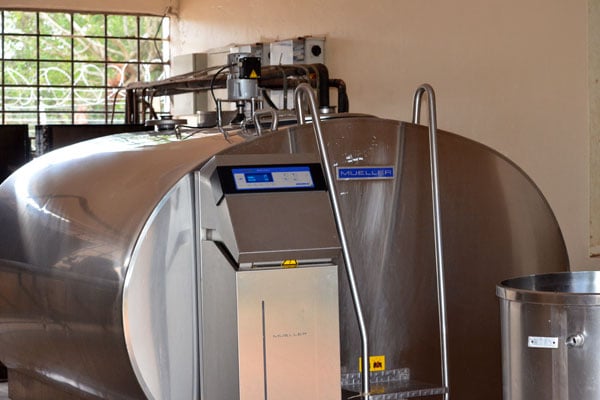Prime
Solar-powered milk coolers to cut losses

Solar-powered milk cooler. Dairy farmers have been advised to use this technology. Photo/George Katongole
What you need to know:
- Solar-powered milk chilling plants are set to save dairy farmers from wastage and reduce operation costs under a new programme implemented by Heifer International in the cattle corridor.
Solar power is not a silver bullet in offering energy solutions but it is an integral energy source in the agriculture value chain.
Solar power can be used for crop irrigation, provision of power to milk chilling, coffee pulping, grain milling as well as fuelling ice plants for fishing communities. It is also effective in post-production activities such as fruit and coffee drying.
Such is the value of solar power generation as it is consistent with nature, clean and renewable. In the cattle corridor of Uganda, where many milk collection centres are off the hydroelectric grid, solar energy is important in driving the production costs down.
According to the FAO statistics of 2020, despite a sizable cattle population, many African countries rely on dairy imports to satisfy domestic needs.
Benefits
While challenges such as poor herd management, substandard feed availability and the small scale of operations contribute to poor productivity, the lack of rural chilling infrastructure, resulting in high post-harvest losses of as high as 40 percent, is seen as the main barrier to sectoral growth. A green initiative funded by Heifer International in partnership with Energy for Impact and Carbon Trust through the Powering Renewable Energy Opportunities (PREO) programme was launched in Ddwaniro village in Kiboga District with an aim of boosting smallholder farmers’ income.
The development organisation is connecting the five off grid milk collection centres with solar power to enable them to increase their efficiency and reduce wastages.
According to the project manager Solar for Sustainable Income in Dairy, Edna Nyamwaka, the project will be established at five pilot dairy cooperatives in the cattle corridor. The two-year pilot project has attracted an investment of €1m (about Shs4b) with the first three beneficiaries expected to be installed by March 2023 while the scale up phase will run until 2024. Excess electricity will be used to power some cottage industries such as cottage enterprises around the cooperatives such as food stores, among others. Dwaniro Livestock Dairy Cooperative was the first beneficiary of the project with an installed capacity of 40.5kw.
“This will help reduce cooperative operating costs and cut carbon emissions by at least 90 percent,” Nyamwaka said during the ground-breaking ceremony at Dwaniro Dairy Farmers Cooperative Migina milk collection centre.
Other beneficiaries include Kiboga Livestock Cooperative and Nabitanga in Sembabule District. Two others – Muyenga Dairy Cooperative and Maddo Dairies will be installed with solar systems in scaled up phase. The total capacity expected is about 106kw to serve electricity to farmers while attempting to reduce use of diesel generators.
John Ssenyonga, the Director of Programs at Heifer International Uganda stated that the project uses a business model of a power purchase agreement and asset financing such that cooperatives pay for the power they use monthly. Heifer International deals with solar technology companies such as Aptech to make the investment and then set an agreement with the cooperative to pay for only power. Jesa Diaries will buy the milk from the farmers. This arrangement runs for about eight years after which the facility is owned by the cooperative. At that time, they take up the operation and maintenance costs.
Great need
Johnson Kwesigabo, the chairman of Dwaniro Cooperative says the need is great. Kwesigabo says the cooperative, which started with a total collection of 2,000 litres, is making huge losses. With the current milk collection at 34,000 litres daily, power outages pose a great challenge. “Dwaniro is an isolated area which is about 5km away from the grid and we have to depend on diesel generators for cooling the milk. We have sustained a lot of losses during power failures. In September and October this year, about 10 trucks of milk with a capacity of 10,000 litres were rejected by Jesa when the generators had broken down. Each truck is about Shs15m, so you can see the size of the loss,” he says.
William Matovu, the country director for Heifer International notes that in order to reduce overreliance on diesel generators, which raise the cost of running the milk aggregation centres, solar energy is the best alternative. He says over 12 years, Heifer International has worked with 87 dairy cooperatives across the country with more than 244 milk collection centres.
However, he states, 197 milk collection centres depend on diesel run generators as a source of energy to chill milk. “The current increase in fuel prices is eating up an estimated 50 percent of their operation costs,” he says.
Consumer awareness
Brian Isabirye, the commissioner renewable energy at the Ministry of Energy and Mineral Development says much as the renewable energy sub-sector is a key player in sustainable agriculture development, awareness is critical.
“People must appreciate that we can use solar to chill milk instead of commercial electricity. Farmers must appreciate that solar is affordable and clean. That would make farmers pay for the equipment,” Isabirye says, stressing that solar will become more acceptable with increased access to financing and quality equipment.
Besides addressing energy inefficiencies, Heifer International is making interventions related to climate change such as pasture conservation, water conservation as well as access to finance for cooperatives wishing to have milk chilling facilities.
Project
The project uses a business model of a power purchase agreement and asset financing such that cooperatives pay for the power they use monthly. Heifer International deals with solar technology companies such as Aptech to make the investment and then set an agreement with the cooperative to pay for only power.




